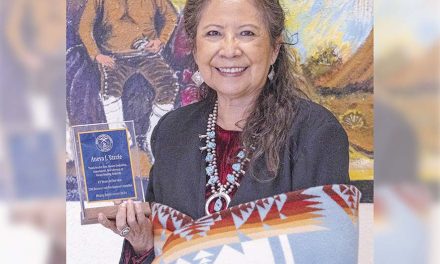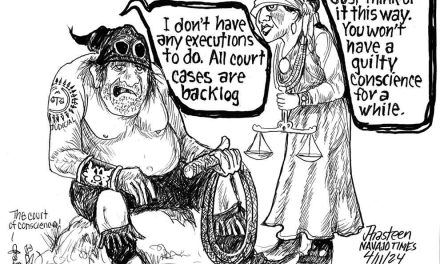
Letters: Delegate should be removed
The behavior of this delegate (“Delegate says person he sexted with is blackmailing him,” “No fallout yet from delegate’s revenge porn incident,” Feb. 21, 2019) should not be condoned by the Navajo Nation president and the speaker. He should be removed from office. There needs to be some control by the administration on the conduct of our delegates.
If there is a removal of a supervisor without cause then this should also apply to our delegates who are looked up to by our whole Navajo Nation. For the president and speaker not to address this issue, it’s telling people that code of conduct is not important.
This is a shame!
Raymond Smith
Sacramento, Calif.
Energy co. hiding truth behind propaganda
Navajo Transitional Energy Company does not want the public to know the truth behind their propaganda on Navajo Generating Station and Kayenta. Based on NTEC’s press release and PowerPoint given during the Naa’bik’iayat’i Committee work session, and a presentation by Bernard Masters, general counsel for NTEC, before the Arizona House’s Federal Relations Committee on Jan. 30, (http://azleg.granicus.com/MediaPlayer.php?clip_id=21802&autostart=0)
NTEC is claiming estimated coal royalties of $260 million over 10 years. This means that something’s getting cut. Either NTEC plans to operate the plant at 55 percent capacity, or generate 1,237.5 MW of coal-fired energy, or operate 1.65 of two units.
To this day, NTEC’s leadership keeps avoiding the question of who exactly will be the buyers for the power from NGS that can make financials pencil out.
Currently, there are no commitments from either Salt River Project, Bureau of Reclamation, or anyone else to continue buying power from NGS. As it stands, SRP and BOR combined, only buy 500 MW.
That means, then, that NTEC not only has to deal with making sure that the ongoing sale of 500 MW is maintained somehow, but it must also find a way to sell the remainder or a portion of that 737.5 MW to another buyer, which NTEC to this day does not know and has not found.
Until there is a signed commitment and publicly known names, it is all hearsay and wishful thinking. Are we supposed to sign the Navajo Nation’s entire economic future away based on mere hearsay and empty slogans of “vertical alignment?” This is a classic case of placing a wagonload of coal ahead of the horses and expecting the horses to push, not pull the wagonload of Kayenta coal uphill, with no buyer at the other end.
Regardless of which scenario ends up materializing, even if the coal plant is somehow kept operating past 2019, something will have to be cut and it will likely mean cutting back on jobs and workers’ benefits to keep NGS and Kayenta on life support. Yet NTEC’s propaganda mailings, flyers, radio ads and newspaper ads are saying “no layoffs” of Navajo employees and claiming that 700 jobs would be saved.
NTEC’s cover up of information extends beyond just the question of who will buy the power from NGS and jobs — it touches other big issues like power pricing and revenue generation, among other equally important factors. Slide No. 3 of the noted PowerPoint says that the “profitable” price for MWH of power is $28.05/MWH.
The current market price for MWH is $25/MWH. We understand SRP has stated they would buy only at the market price. And according to NTEC, estimated coal royalties of $260 million over 10 years would be $26 million a year — that is less than what the Navajo Nation has been receiving.
So then why is NTEC saying, “We will be losing $40 million/year” when that is not true? With what little information is trickling out of NTEC, one wonders why Peabody and NTEC are hell bent on misinforming the Navajo Nation into buying NGS and Kayenta Mine? Why?
We have to ask ourselves why we had the world’s leading private equity investment firms look at NGS, only to see them all walk away. Their reason is that they see what everyone already knows — there is no money to be made in this NGS/Kayenta arrangement. The only one that wins is Peabody, which could potentially get off scot-free and walk away from its responsibilities owed to the Navajo Nation, after decades of profiting off our land.
What is alarming is they are maliciously attacking volunteer community organizations like Diné CARE that are only making factual information available to the public so an informed decision can be made — information that is not being provided by NTEC.
Access to information is critical such as the list below of assets and revenues that the Navajo Nation will actually lose should it buy NGS, as it would make the current closure deal null and void. What the Navajo Nation will lose if NTEC buys Navajo Generating Station: (Asset, term, dollar value)
- NGS Rental Agreement cash payment, 35 years, $110 million.
- Coal Revenue guarantee payment, 2 years, $39 million.
- Shared saving in building demolition, 3 years, $18 million.
- Payment to the Navajo Division of Economic Development, one-time, $275,500. • Various assets, one-time, $1.7 million.
- Coal railroad, one-time, $120 million.
- Lake pumping system, switchyard and distribution line, one-time, $4l million.
- Warehouse, parking lot and land, one-time, $2 million.
- Transmission Access and 10 years of utility maintenance, 35 years, $80 million.
- 1,500 acre-feet of NGS water, 35 years, $38,070.
- 950 acre-feet of water for LeChee Chapter, perpetuity, $24,111.
- New landfill cell, perpetuity, NA. Total = $412,037,681.
Financially, we would do better by allowing NGS to shut down as proposed by the owners and it would be the only sane choice. The real value is in decommissioning, where the liabilities are with the present NGS owners. This option far outweighs any irresponsible attempts to keep the old coal stove burning only to burden ourselves with liabilities for the next century.
For this reason, we thank the Council delegates speaking on behalf of their constituencies to support making informed decisions and having all of the truth exposed.
Lori Goodman
Dilkon, Ariz.
5-year-old’s question a wake-up call
When a five-year-old child observes and asks why our community is all “broken,” unlike her cousin’s community in the Valley (Phoenix), that should be a real wake-up call on some basic economics.
Although we hear much talk and see mounds of paperwork compiling the usual statistics on Navajo Nation demographics and economics, our five-year-old’s observation and other similar expressions leads to the elusive question: Why it is that we always seem to repackage old rhetoric with new rhetorical political language?
It is no great revelation that campaign promises come and go with every election and after the elections are said and done, there is still unacceptable unemployment rate, “broken” communities that dot our landscape, the endless list.
The harsh socio-demographic baseline data compiled by the national and Navajo Nation census from 2000 to 2010 remains essentially unchanged seemingly reserved for the next election, the next generation.
As we survey our landscape today, based on our election cycle, we can predict what the Navajo Nation 2020 socio-demographic census data will look like. These numbers in the census are very important, especially where quantity translates to quality.
These big data are not just numbers. Behind these numbers are real people – youth, adults, elderly, in real time, in real settings of lives, homes, health, jobs, families, respectful of the elected leadership to deliver on real-world results. In its stead, decades pass and still we witness the alarming increase in foreign corporate affluence and privilege for a few while widespread deleterious life conditions dot our landscape.
In broad daylight, wealthy corporation shareholders, big and small, continue to drown out voices from the field all the while capitalizing on pockets of dire, challenging ground-level life conditions of our people.
Why our Navajo Nation economic engine stalls on these important matters should give pause for questions on predatory profiteering from abroad.
Rear-view mirror tells us somewhere along the line, privileged political complacency using “people’s money” always seems to set in, a system failure in people whom had been entrusted to lead.
While our five-year-old youngster is saddened by the “broken” community where the most vulnerable – our kids – can’t play, observations as such should be illuminating enough to where unsettling, uncomfortable questions are raised on the urgent need to craft new outcome-driven, breakthrough evidence-informed economic policies to empower under-resourced communities, neighborhoods and our people.
Is it now time to put the “peoples’” money where the money is needed most, namely investment in our people. Massive documentation sheds light on how education and economics go hand-in-hand. Our seemingly entrenched socio-demographics in our homeland, which are not natural unalterable conditions but are man-made socioeconomic engineering, are too telling not to make human-capital investment a priority.
Given greater people investment, it may well be worth the time to give serious thought to what the next Navajo Nation socio-demographic census data will look like a few years down the road. Indeed, if we could but only give life to our bedrock proverbial traditional wisdom, “t’aa whiiajiit’eego eiya la’hoot’i,” leveraged by investment in our people, there may be changes for broadly shared prosperity, “… a greater good for greater numbers.”
Although hopes, dreams, families and prayers are reminders and guides for life realignment, we should just stay the course and take on the hard work required to doing anything well, to earn anything worth having, regardless of distractions, chuck holes and other road hazards. Common sense dictates that we move away from putting scarce funds in only a few baskets that serves more to sustain the scathing contours and the debilitating effects thereof of unequal concentration of economic resources within our homeland. And yet, here we have a wealth of unrealized human capital knocking on our door awaiting priority investment in our people.
There are many among us, many veterans, who feel they did not sacrifice greatly to earn their expensive cross-cultural education just to see the dreams and hopes of our people continually eradicated. With the new elections, one would think the priority for the day would be to take a step back to gain fresh perspectives, discard assumptions and move away from economic policies and practices where rear-view mirror tells us of a massive widespread straggling Navajo Nation economic system, which again are the results of human decisions.
Should we not give some attention to our five-year-old child’s thoughtful observation that maybe high-quality rigorous education and cultural rootedness may well have the highest value in the healthy socio-economic growth equation? When will our youth, our people, not always have to look from outside the window into communities of “life, liberty, and happiness” off our homeland?
Harold G. Begay
To’Nanees’ Dizi, Ariz.
To read the full article, pick up your copy of the Navajo Times at your nearest newsstand Thursday mornings!
Are you a digital subscriber? Read the most recent three weeks of stories by logging in to your online account.







 Highway 264,
Highway 264, I-40, WB @ Winslow
I-40, WB @ Winslow